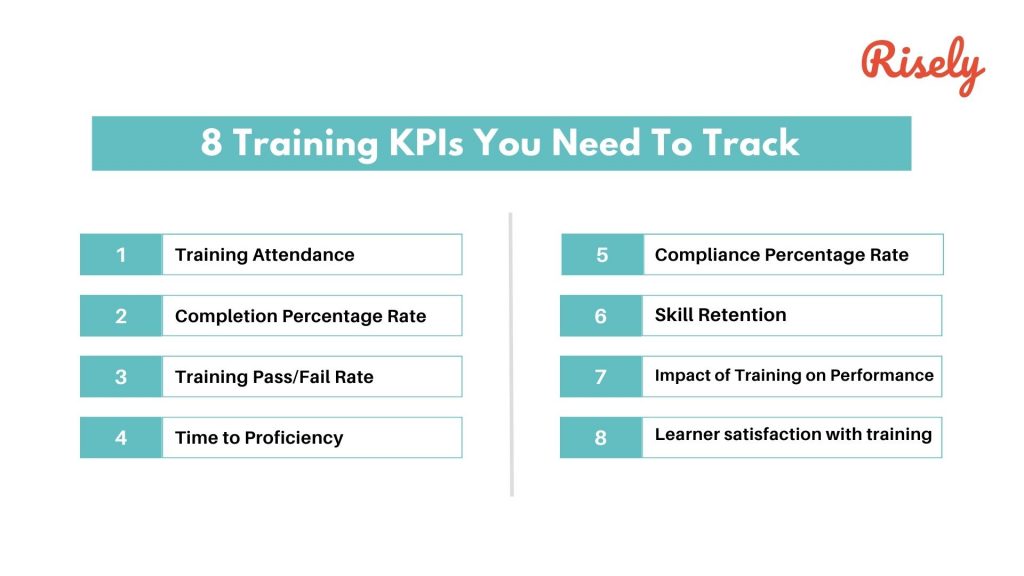Top 8 Training KPIs You Need To Track
Are you tired of investing time and resources into training programs without knowing if they are truly effective for you? It’s time to start tracking your training initiatives’ right Key Performance Indicators (KPIs). In this blog, we will dive deep into the world of training KPIs and explore their importance in measuring the success of your training programs. From understanding the critical metrics for training success to assessing the impact of training on job performance, we will cover it all. You will also learn to track attendance, completion rates, proficiency levels, knowledge retention, and learner satisfaction. Don’t let your training efforts go unnoticed – start monitoring the top 9 training KPIs today and take your learning and development strategy to new heights.What are the KPIs for training?
KPIs, or Key Performance Indicators, are measurable values that help businesses track and evaluate their progress toward achieving specific goals or objectives related to learning and development. KPIs provide a way to assess performance and determine whether a business is on track to meet its targets. Training KPIs are metrics used to measure the effectiveness and success of training programs. They provide insights into how well employees progress and develop their skills and knowledge. Common KPIs include employee satisfaction, completion rates, competency improvement, and cost per trainee. Other important KPIs have knowledge retention rates, time to proficiency, and ROI. Choose KPIs that align with your training goals and objectives to get an accurate picture of the impact of your training and development programs. Read more: Understanding Training Metrics And Its Types With 8 Best Implementation PracticesImportance of tracking training KPIs
Tracking training KPIs is essential for several reasons : Firstly, it allows teams to measure the effectiveness and impact of their training programs. L&D managers can assess whether their training initiatives achieve their intended outcomes by tracking learner satisfaction, knowledge retention, and performance improvement metrics. L&D professionals can use this information to make informed decisions about future training investments and adjustments to existing programs. Secondly, tracking training KPIs provides valuable data for evaluating training initiatives’ return on investment (ROI). L&D managers can determine whether their training efforts are delivering a positive ROI by comparing the cost of training to the benefits gained from improved employee performance and productivity. Furthermore, tracking KPIs helps identify areas for improvement in training programs. L&D professionals can pinpoint areas where additional support or modifications may be needed by monitoring metrics such as completion rates, time to proficiency, and skills development. Tracking training KPIs allows L&D teams to make data-driven decisions regarding their training programs, improve program effectiveness, and demonstrate the value of training investments to stakeholders.Other Interesting Reads
What are the Key Training KPIs?
Training Attendance
Training attendance refers to the number of participants or employees who attend a training session or program. It is a helpful KPI for training because it provides insights into the effectiveness and engagement of the training program. By tracking training attendance, teams can assess the level of interest and commitment among employees, identify any gaps in participation, and evaluate the overall success of the training initiative. A high attendance rate generally indicates that employees value the training and actively seek to improve their skills and knowledge. On the other hand, a low attendance rate may suggest barriers or challenges preventing employees from participating fully in training, which can help L&D teams address these issues and improve future programs.Training Completion Percentage Rate
The training completion rate is a training KPI measuring the percentage of employees who complete a training program or course. It is calculated by dividing the number of employees who completed the training by the total number of employees enrolled in the program and multiplying by 100 to get the percentage. Training completion rate is a useful KPI because it provides insights into the effectiveness and engagement of your training initiatives. A high completion rate indicates that employees actively participate in and complete the training, suggesting that they are motivated and interested in developing their skills and knowledge. On the other hand, a low completion rate may indicate potential issues with the training program, such as content that is not engaging or relevant to employees’ needs or scheduling conflicts that prevent employees from completing the training. By monitoring and analyzing training completion rates, L&D managers can identify areas for improvement and adjust their training programs to ensure maximum participation and success. Read more: Understanding Motivation Of Training With 6 Effective Strategies And BenefitsTraining Pass/Fail Rate
The Training Pass/Fail Rate is a metric that measures the percentage of trainees who successfully pass a training program or course. It is a valuable training KPI because it provides insights into the training program’s effectiveness and the trainees’ proficiency level. A high Pass Rate indicates that the training program successfully imparts the necessary knowledge and skills to the trainees, leading to a higher level of competency. It can be an indication of a well-designed and well-executed training program. On the other hand, a low Pass Rate may indicate areas for improvement in the training program. It could suggest that the content or delivery methods must be revised or that additional support and resources are required for trainees to complete the program successfully. By tracking the Pass/Fail Rate, L&D teams can identify areas where their training programs may fall short and make necessary adjustments to enhance their effectiveness.
Time to Proficiency
Time to proficiency refers to the time it takes for an employee to become fully proficient in their role or job function. It is a valuable training KPI because it provides insights into the effectiveness of the training program and how quickly employees can acquire the necessary skills and knowledge to perform their job tasks. By tracking Time to Proficiency, L&D teams can assess the efficiency and effectiveness of their training programs and make necessary adjustments to improve employee onboarding and development. A shorter Time to Proficiency indicates that employees can quickly learn and apply new skills, resulting in increased productivity and reduced time spent onboarding new hires. Additionally, Time to Proficiency can help identify gaps in training materials or methods, allowing teams to refine their training programs and ensure employees have the resources to succeed. It also helps evaluate the overall performance of different organizational departments or teams by comparing their Time to Proficiency metrics.Compliance Percentage Rate
Compliance Percentage Rate (CPR) is a metric used to measure compliance with a set of standards, regulations, or guidelines within a training program. It represents the percentage of individuals who have completed training requirements or demonstrated compliance with specific standards. CPR is a useful training KPI because it provides insights into the effectiveness of training programs in ensuring that employees or participants understand and adhere to important policies, procedures, and regulatory requirements. A high CPR indicates a high level of compliance, which can help mitigate risks, ensure consistency, and maintain quality standards within an organization. On the other hand, low CPR may indicate gaps in training effectiveness or the need for additional reinforcement and support to improve compliance rates. By tracking CPR over time, L&D teams can identify trends and make informed decisions to enhance their training initiatives and promote a culture of compliance. Read more about building culture here: Develop leaders for a self-propagating cultureSkill Retention
Skill retention refers to the ability of an individual to retain and maintain the knowledge, skills, and competencies they have acquired through training or learning initiatives. It measures how well individuals can apply what they have learned over time. Skill retention is a useful training KPI because it helps teams assess the effectiveness of their training programs. By tracking skill retention, L&D managers can determine if employees can retain and apply the knowledge and skills learned in training sessions. A high skill retention rate indicates that the training has successfully transferred knowledge and skills to employees, leading to improved performance on the job. It also suggests that employees are more likely to utilize their newly acquired mastery over the long term, positively impacting productivity, efficiency, and overall organizational performance. On the other hand, a low skill retention rate may indicate issues with the training program, such as ineffective delivery methods or lack of reinforcement activities. By monitoring skill retention as a KPI, teams can identify areas for improvement in their training programs and take corrective actions to ensure better knowledge transfer and long-term skill development.Impact of Training on Job Performance
Training has a significant impact on job performance. When employees receive adequate training, they gain the knowledge, skills, and confidence necessary to perform their job duties at a higher level. It leads to improved job performance in terms of productivity, quality of work, and efficiency. Job Performance Impact is a useful training KPI because it allows L&D teams to measure the effectiveness of their training programs and assess the impact on employee job performance. By tracking the impact on job performance through pre-and post-training assessments and on-the-job performance metrics, teams can evaluate their training initiatives’ return on investment (ROI) and make informed decisions about future training needs. Furthermore, using job performance as a training KPI helps L&D professionals identify areas where additional training or support may be needed to enhance employee skills and knowledge. It provides valuable insights into individual and team strengths and weaknesses, allowing for targeted interventions that ultimately improve overall job performance and contribute to organizational success. Read more: The Role Of Feedback In Training And Employee Retention: With 5 Effective ExamplesLearner satisfaction with training
Learner satisfaction refers to the level of contentment or fulfillment that learners experience during and after a training program. It measures how satisfied learners are with various aspects of the training, such as the content, delivery methods, instructor effectiveness, and overall learning experience. For several reasons, learner satisfaction is a useful training KPI. Firstly, it provides valuable feedback on the effectiveness of the training program. If learners are delighted, it indicates that the program is meeting their needs and expectations. On the other hand, low learner satisfaction may suggest areas for improvement or changes needed in the training design or delivery. Secondly, learner satisfaction can impact engagement and motivation levels. When learners are satisfied with their training experience, they are more likely to be engaged in the learning process and motivated to apply what they have learned. Lastly, learner satisfaction can also influence knowledge retention and skills transfer to the workplace. A positive training experience enhances learners’ likelihood of remembering and effectively applying what they have learned in real-world situations. Read more: How to Strengthen Workplace Learning with Learner Feedback?Conclusion
Tracking training KPIs is crucial for evaluating the effectiveness of your training programs and ensuring that they align with your business goals. By measuring key metrics such as training attendance, completion rates, time to proficiency, and impact on job performance, you can identify areas for improvement and make data-driven decisions to enhance the overall training experience. Additionally, assessing learner satisfaction with training helps you gauge your employees’ engagement and motivation levels, leading to higher retention and better performance outcomes.Rethink L&D for effectiveness with Risely’s free resources.
Grab your free copy of Risely’s L&D strategy framework today and get started.
Training KPIs FAQs
What is the KPI for training and development?
Key Performance Indicators (KPIs) for training and development are measurable values that help assess the effectiveness and progress of training initiatives. They provide insights into the impact of training programs on individual and organizational performance.
What is KPI for training hours?
A common KPI for training hours is the number of training hours per employee. It measures the amount of time employees spend on training activities, indicating the level of investment in their development.
What are some training metrics?
Some training metrics include training completion rates, post-training assessments or evaluations, skill proficiency improvements, employee satisfaction or feedback, training cost per employee, and time to proficiency. These metrics help gauge the effectiveness, efficiency, and outcomes of training programs.
What are the objectives of KPI training?
The objectives of KPIs in training include:
– Assessing the effectiveness and impact of training initiatives on employee performance and skill development.
– Identifying areas of improvement and measuring progress towards learning and development goals.
– Providing data-driven insights for making informed decisions on training investments, resource allocation, and program design.
– Assessing the effectiveness and impact of training initiatives on employee performance and skill development.
– Identifying areas of improvement and measuring progress towards learning and development goals.
– Providing data-driven insights for making informed decisions on training investments, resource allocation, and program design.
Other Related Blogs
10 Signs You’re Struggling with Analysis Paralysis at Work
10 Signs You’re Struggling with Analysis Paralysis at Work The smart fox declares, “I have a hundred ways to escape when trouble approaches. You have only one.” As the dogs…
Evidence Based Decision Making: 4 Proven Hacks For Managers
Evidence Based Decision Making: 4 Proven Hacks For Managers In this blog, we will explore the concept of evidence-based decision-making and provide seven proven hacks for managers to implement evidence-based…
6 Best Books On Decision Making For Managers
6 Best Books On Decision Making For Managers Effective decision-making is crucial for managers to navigate the complexities of their roles. You are responsible for making important choices that can…
Best Decision Coaches To Guide You Toward Great Choices
Best Decision Coaches To Guide You Toward Great Choices Effective decision-making is more crucial than ever in today’s rapidly evolving business landscape. Entrepreneurs, leaders, and professionals alike are constantly faced…


